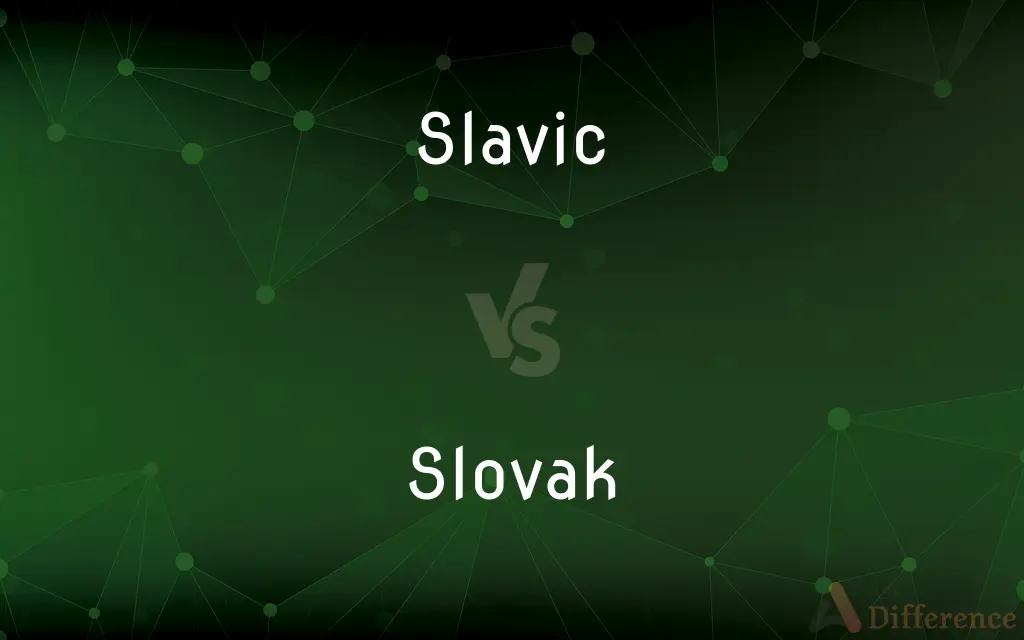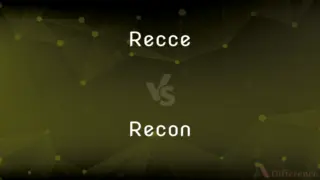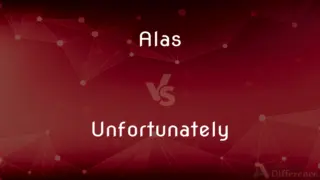Slavic vs. Slovak — What's the Difference?
By Fiza Rafique & Maham Liaqat — Updated on March 26, 2024
Slavic refers to a linguistic and cultural group in Europe, while Slovak pertains specifically to anything related to Slovakia.

Difference Between Slavic and Slovak
Table of Contents
ADVERTISEMENT
Key Differences
Slavic is a term that encompasses a wide ethnic and linguistic group originating from Eastern Europe, which includes a diverse range of peoples, languages, and cultures. This group is divided into East Slavic, West Slavic, and South Slavic peoples, each with their own distinct languages and traditions. On the other hand, Slovak refers specifically to the nationality, language, and culture of Slovakia, a country in Central Europe, and its people. Slovak is a part of the West Slavic subgroup, sharing cultural and linguistic ties with Czechs, Poles, and others in the region.
While the Slavic group includes numerous languages such as Russian, Polish, Czech, Serbian, and Bulgarian, Slovak is the official language of Slovakia, with its unique vocabulary, grammar, and pronunciation. The Slovak language and culture are specific manifestations of the broader Slavic heritage, showcasing the unique identity and traditions of the Slovak people within the larger Slavic context.
The Slavic identity is characterized by a shared historical background, cultural similarities, and linguistic roots that date back to the early Middle Ages. This broad categorization emphasizes the commonalities among the Slavic peoples. In contrast, Slovak identity focuses on the particular history, traditions, and language of Slovakia, highlighting its distinct place within the Slavic world.
Culturally, the Slavic peoples celebrate a variety of traditions, festivals, and folklore that reflect their ancient heritage and communal ties. Slovak culture, while part of this larger Slavic tapestry, has its own unique customs, folklore, and celebrations that are specifically Slovakian, underscoring the diversity within the Slavic community.
Despite the broad scope of the Slavic designation, the Slovak language and identity remind us of the importance of recognizing the individual characteristics and contributions of each Slavic nation to the cultural mosaic of Europe.
ADVERTISEMENT
Comparison Chart
Definition
Pertains to the ethnic and linguistic group in Europe.
Relates specifically to the nationality, language, and culture of Slovakia.
Subgroups
Divided into East, West, and South Slavic.
A part of the West Slavic subgroup.
Languages Included
Includes Russian, Polish, Czech, Serbian, Bulgarian, etc.
Slovak language only.
Geographic Scope
Covers a wide area in Eastern, Central, and Southern Europe.
Limited to Slovakia.
Cultural Identity
Broad, encompassing a variety of traditions across nations.
Specific to Slovakia’s unique traditions and history.
Compare with Definitions
Slavic
Diverse but interconnected.
Despite differences, Slavic countries share cultural similarities.
Slovak
Nationality related to Slovakia.
Slovak citizens are proud of their heritage.
Slavic
Shares common historical roots.
Slavic peoples trace their origins back to early medieval tribes.
Slovak
West Slavic language.
The Slovak language is spoken by over 5 million people in Slovakia.
Slavic
Includes various languages.
Polish and Russian are among the Slavic languages.
Slovak
Specific cultural traditions.
Slovak folklore is rich with unique legends and customs.
Slavic
Ethnic and cultural group.
Slavic traditions are celebrated across Eastern Europe.
Slovak
Identifies people from Slovakia.
Slovak athletes compete under their national flag.
Slavic
Widespread across Europe.
Slavic nations are found from Russia to the Balkans.
Slovak
Part of the Slavic group.
Slovakia contributes its unique culture to the Slavic community.
Slavic
Of or relating to the Slavs or their languages.
Slovak
A native or inhabitant of Slovakia.
Slavic
Of or relating to the branch of the Indo-European language family that includes such languages as Russian, Serbo-Croatian, and Polish, and is composed of the East Slavic, South Slavic, and West Slavic subdivisions.
Slovak
A person of Slovak ancestry.
Slavic
The Slavic branch of Indo-European.
Slovak
The Slavic language of the Slovaks.
Slavic
Slavonic.
Slovak
Of or relating to Slovakia or its people, language, or culture.
Slavic
A branch of the Indo European family of language
Slovak
A native or inhabitant of Slovakia
Slavic
Of or relating to Slavic languages
Slovak
The Slavic language spoken in Slovakia
Common Curiosities
Can the term "Slavic" be used interchangeably with "Slovak"?
No, "Slavic" refers to the broader ethnic and cultural group, while "Slovak" specifically relates to the nationality and culture of Slovakia.
What defines the Slavic group?
The Slavic group is defined by ethnic, linguistic, and cultural commonalities shared by peoples across Eastern, Central, and Southern Europe.
Are all Slovak people considered Slavic?
Yes, Slovak people are part of the broader Slavic ethnic and cultural group, specifically within the West Slavic subgroup.
How did the Slavic group come to be?
The Slavic group evolved from common ancestral roots in early medieval times, expanding and diversifying across a large part of Europe.
How is the Slovak language preserved and promoted?
The Slovak language is preserved through education, cultural practices, and official use in government and media in Slovakia.
What makes Slovak distinct within the Slavic group?
Slovak is distinct for its specific national identity, language, and culture unique to Slovakia, a country in Central Europe.
How do the languages within the Slavic group differ?
Languages within the Slavic group vary in vocabulary, grammar, and pronunciation, divided into East, West, and South Slavic branches.
Is the Slovak language understood by other Slavic speakers?
Slovak can be somewhat intelligible to speakers of closely related Slavic languages, especially Czech, but less so to those of distant Slavic languages.
What role does Slovakia play in the Slavic community?
Slovakia contributes its unique cultural traditions, language, and history to the richness and diversity of the Slavic community.
How is Slovak culture unique from other Slavic cultures?
Slovak culture is characterized by its own folklore, traditions, and language, reflecting Slovakia's unique history and geographic setting.
Do political boundaries affect the Slavic identity?
While political boundaries do influence national identities, the Slavic cultural and linguistic identity transcends these borders, uniting diverse peoples with common roots.
What challenges face the preservation of Slavic languages and cultures?
Challenges include globalization, cultural assimilation, and the diminishing use of some languages in younger generations.
What is the significance of the Slavic cultural identity?
The Slavic cultural identity signifies a shared historical background and cultural heritage among diverse nations in Europe.
Are there significant cultural differences within the Slavic group?
Yes, despite shared origins, there are significant cultural, linguistic, and historical differences among the Slavic nations.
What are some common Slavic traditions?
Common Slavic traditions include folk music and dance, celebration of Slavic heritage festivals, and specific culinary practices.
Share Your Discovery

Previous Comparison
Recce vs. Recon
Next Comparison
Alas vs. UnfortunatelyAuthor Spotlight
Written by
Fiza RafiqueFiza Rafique is a skilled content writer at AskDifference.com, where she meticulously refines and enhances written pieces. Drawing from her vast editorial expertise, Fiza ensures clarity, accuracy, and precision in every article. Passionate about language, she continually seeks to elevate the quality of content for readers worldwide.
Co-written by
Maham Liaqat













































